- Home
- Ann M. Martin
Claudia and the Mystery in the Painting
Claudia and the Mystery in the Painting Read online
Contents
Title Page
Chapter One
Chapter Two
Chapter Three
Chapter Four
Chapter Five
Chapter Six
Chapter Seven
Chapter Eight
Chapter Nine
Chapter Ten
Chapter Eleven
Chapter Twelve
Chapter Thirteen
Chapter Fourteen
Chapter Fifteen
Acknowledgment
About the Author
Also Available
Copyright
“Claudia! I didn’t know you were going to stop by today.” My mom stood in the doorway leading to her office behind the main desk at the Stoneybrook Public Library.
I have to admit that the library isn’t my favorite place, even though my mom is the head librarian. That’s because books and I, Claudia Kishi, don’t mix very well — especially school books. Nancy Drew books are a different story. I have them hidden all over my room so I can read one anytime I feel like it. They’re hidden because my mom and dad don’t consider Nancy Drew “worthwhile reading.”
But today I was surrounded by all kinds of worthwhile reading and Mom looked a little surprised as she walked out from behind the desk and gave me a hug. She was wearing a pair of earrings I’d made her: tiny books that really open, hanging from silver wires. The earrings were the only thing that saved her outfit from being totally boring. She wore a plain black skirt and a plain red blouse, and it made her look like — a librarian. There’s nothing wrong with that exactly, but I wouldn’t be caught dead in anything so ordinary.
Clothes are sort of a hobby for me. I try never to wear the same outfit twice. Today I had on navy blue pants with wide legs, red suspenders decorated with big sunbursts, a white T-shirt, and over it all, a huge red-and-white-checked shirt. My earrings were also bright yellow sunbursts that I made to match the suspenders. My hair was in one long braid hanging down my back, tied with a red-and-white-checked bow. Except for the fact that we’re both Japanese-American and have the same color hair and eyes, no one would ever guess that Mom and I are related.
This doesn’t mean I love my mom any less. In fact, my entire family is pretty cool, even if they don’t look it. My dad’s a partner in an investment firm in Stamford, the city nearest to Stoneybrook, Connecticut, where we live. I have one sister, Janine. Mom wouldn’t be a bit surprised if she turned up at the library. That’s because Janine is a full-fledged, authentic genius, with the IQ to prove it. She loves school, books, computers, and all of that stuff. She’s a junior at Stoneybrook High School, but she also takes classes at Stoneybrook University in all kinds of things I can’t pronounce, let alone spell or understand.
I’m in the seventh grade at Stoneybrook Middle School. I used to be in the eighth grade, but I fell too far behind in my work, so I went back to catch up. It’s not that I’m dumb, it’s just that school is … well, school. It’s hard for me to work up a lot of excitement over math and science and spelling when I have all these great ideas in my head. And I do get A’s in some classes, such as art.
I love art — painting, sculpting, photography, you name it — and I know I’ll use the things I learn in art class. I already do, every day. Mom’s and my earrings are just one example. I’ve taught an art class, I’m an honorary trustee at the Stoneybrook Museum, and I use art all the time when I’m baby-sitting.
I love to baby-sit almost as much as I love art. I belong to this very cool club called the Baby-sitters Club, or BSC, along with some of my friends who like kids as much as I do. But I’ll tell you more about that later.
Actually, it was a combination of baby-sitting and art that had brought me to the library. Of course, Mom didn’t know that, and she asked (hopefully, I thought), “Are you working on an assignment for school?” When I was in eighth grade and often behind, Mom, Dad, and Janine pitched in to help me with my homework, so you can see why Mom would be excited to think that I might be getting a head start on it. My grandmother, Mimi, used to help too, but she died not long ago. I still miss her.
“I’m trying to find out something about Grandmother Madden, an artist,” I said, once again shattering my mom’s hopes that some of Janine was rubbing off on me. Although I know my parents are every bit as proud of me as they are of my sister, I think they wish I were a little more like her in some ways. Then again, maybe they wish she were like me in some ways.
“Grandmother Madden?” Mom looked blank. “What’s her full name?”
“Grandmother Madden,” I repeated. “That’s how she signed her artwork and how she’s known. She’s a folk artist who painted in the primitive style, and she used to live here in Stoneybrook. I’m baby-sitting for her great-grandson tomorrow. His mom inherited her grandmother’s house and is getting it ready to sell.”
Right in front of my eyes Mom changed into Superlibrarian. I could almost see the outline of a cape trailing behind her. “We can look under Madden, primitive art, folk art, local artists,” Mom said as I followed her to the electronic card catalog. Using the electronic card catalog is something I learned to do almost as soon as I learned to read. Mom knew this, but I could tell she wanted to find out about Grandmother Madden too. There are no limits to Superlibrarian’s curiosity.
We didn’t find anything under Madden, but there was a book called Primitive Artists of the Twentieth Century and another with the title Folk Art.
Again I followed Mom, to the shelves this time. (She didn’t even have to write down the call numbers of the books.) But neither book was there.
Being the head librarian, my mom has her ways of finding out where a book is at all times (thanks to her superpowers and the computer). She clicked a few keys and discovered that both books were checked out. “They’re due in at the end of next week. We can put a request in, so you’ll be notified when they come back,” Mom said, still typing.
“It won’t help me for tomorrow, but go ahead,” I said. I’d become pretty interested in folk art, and I wanted to find out more about it.
“Wait a minute. Did you say she used to live here in Stoneybrook?” Mom’s eyebrows came together and she drummed her fingers on the checkout desk.
I nodded.
“Maybe there’s been something about her in the newspaper.” Mom took off again, and I followed again. This time we ended up at the microfilm machines. All the old issues of the Stoneybrook News are stored on microfilm.
In no time, Mom had Grandmother Madden’s obituary on the screen. She’d been dead for six years. That was weird. Why was her granddaughter just now getting around to selling the house? I knew she hadn’t been living in it, because she’d come to town from New York City. Kristy Thomas, our BSC president, said her mom had given Ms. Madden the BSC’s phone number.
Besides Rebecca Madden — the woman who had called us for a sitter — one daughter, three other grandchildren, and one great-grandson were listed as survivors. The obituary mentioned that Grandmother Madden had taught art in Stoneybrook, but it didn’t say anything about her being an artist.
By the time I finished reading the obituary, Mom had found two more recent articles about Grandmother Madden. They answered all the questions the first article raised but gave me a couple of new ones to think about. They also made me very excited about my new job.
The first article was about folk art in general, but it included a big section on Grandmother Madden:
Folk art, for many years snubbed by the art community for being too simplistic, is finally coming into its own. Artists who once were unable to give their paintings away are now selling their work for undreamed-of prices.
There was also a blurry picture of the auctioned painting. It looked like an old-fashioned village with lots of busy people in it. I read on.
Mrs. Madden’s work features bright primary and secondary colors and minute detail. Her smallest figures are fully developed, down to freckles on the noses of the children and rings and earrings adorning the adult subjects. Clothes sport lace and buttons, and pets may have tiny cobwebs on their whiskers. Looking inside each door and window rewards the viewer with another scene of what is going on inside the building.
I squinted my eyes and tried to see this in the newspaper picture, but I could barely make out the people and buildings, much less jewelry and windows and whiskers on the animals. I’d have to wait until the next day to see one for real. I asked Mom to make me a copy of the article before she loaded the next one.
FIGHT OVER WILL TURNS OUT TO BE FIGHT OVER NOTHING was the headline:
Rebecca Madden, granddaughter of renowned folk artist Grandmother Madden, prevailed in the five-year court battle that began when her cousins challenged their late grandmother’s will.
I compared the dates of the obituary and this article. Grandmother Madden had gone from art teacher to renowned folk artist in six years. I figured that the court case explained why it had taken so long for Rebecca to get around to selling the house.
As it turned out, the battle was over a house rather than the fortune in paintings that the descendants had hoped to find. When Grandmother Madden showed her work in New York City for the last time, sales were disastrous and the reviews brutally negative. After that show, the parties concluded, she destroyed all the paintings still in her possession. No artwork from that show or from any later date can be found. When the cousins learned that they were fighting over a house, they dropped their suit, leaving the entire estate to Rebecca Madden, who is following in her grandmother’s artistic footsteps.
“Mom, how could she do it?” I asked, trying to think of something so bad that it would make me destroy my artwork and stop creating new pieces. I couldn’t think of a thing. My paintings, my jewelry, my sculpture, my photographs, they are all a part of me. It would hurt too much to wipe them out.
The news that many of Grandmother Madden’s paintings had been destroyed quickly raised the value of her existing work. Single paintings owned by each of her grandchildren were estimated to double in value.
“Could you make a copy of this one too?” I asked Mom.
I’d passed by the Madden house many times because it isn’t far from my house. It’s a big, old house set back from the street, and it has a large yard with lots of trees. Inside there could be lots of places to hide things — including pictures. I’d be spending a lot of time there in the next week or so. Maybe I’d have a chance to look around a little.
“Claudia, there are no paintings,” Mom said. “Grandmother Madden destroyed any she’d kept.”
I jumped. Mom seemed to be reading my mind. “I couldn’t, no matter what anybody said, ever, ever destroy all my artwork,” I replied.
“But Mrs. Madden did. It says so in this article.” Mom pointed at the paragraph. “Have you been reading Nancy Drew again?”
“Why do you ask that?” I even laughed a little as I put on my most innocent face and reread what the reporter had written. Who were “the parties”? And how had they “concluded” that she’d destroyed the paintings? I wasn’t convinced.
“You have a baby-sitting job for this family, not a detective job,” Mom reminded me.
Mom knew me well. “Don’t worry,” I said. “I’m just excited about maybe seeing one of these paintings. Each grandchild has one, right? And the article said that Rebecca Madden is an artist too. We’ll have a lot in common.”
I tucked the newspaper articles in my backpack. I couldn’t wait to show them to my friends in the BSC at our meeting that afternoon.
When I got home from the library, it was almost time for our BSC meeting. We meet every Monday, Wednesday, and Friday, from five-thirty (sharp!) until six. Our meetings always start on time, thanks to President Kristy.
I was hungry, and I knew my friends would be too. I uncovered a few snacks (I have to hide junk food around my room, the same way I hide Nancy Drews). I found a package of M&M’s that I’d stuck under my pillow, a couple of Ho-Hos from a box in the closet, and a bag of pretzels that was tucked away in a desk drawer.
As soon as I’d arranged the snacks (meaning, tossed them on the bed) and eaten a handful of M&M’s, I dug out the articles on Grandmother Madden that were in my backpack. I wished I could see more details of the painting, but you can imagine how clear a photocopy of a microfilm copy of a newspaper photo comes out. I thought I saw traces of Stoneybrook in the picture, which wouldn’t be too far-fetched, since Grandmother Madden had lived here. A picture of my room might be fun to try. I could capture a BSC meeting, with all of us sitting around my room. As I reached out for a pad and pencil, Kristy burst into the room and plopped down in the director’s chair.
“What are you drawing?” she asked, twisting to see my pad.
“Nothing yet, but I have this idea. Remember that friend of your mom’s, Rebecca Madden? I’m sitting for her son tomorrow, so I went to the library to look up Grandmother Madden, the artist, Rebecca’s grandmother. I don’t know a lot about her art style. These articles are all I found, but there’s some good stuff about missing paintings and fights over her will. And I’d love to be able to see some of the paintings for myself.” I handed Kristy the clippings, then quickly sketched her into the picture.
A picture of Kristy sitting still isn’t really a picture of her at all. She’s always on the move, full of energy and ideas. One thing she doesn’t waste any of her energy on is deciding what to wear. I’ve known her my whole life and she’s been dressed in jeans, a turtleneck, and running shoes for most of that time. She’s short for an eighth-grader and has brown hair and brown eyes.
Kristy, her mom, her two older brothers, and her younger brother used to live across the street from us. Kristy’s dad took off when David Michael, her younger brother, was a baby. When her mom married Watson Brewer not long ago, they all moved into his mansion across town. They can afford to live in a mansion because Watson is a millionaire. And they need a big house because in addition to the Thomas kids, Watson has two kids from his first marriage, Karen and Andrew, who live there every other month. Mr. and Mrs. Brewer also adopted a little girl from Vietnam, whom they named Emily Michelle. (She’s two and a half now.) Kristy’s grandmother, Nannie, moved in after Emily Michelle arrived, to help with the baby. If that’s not enough, Kristy’s family also has enough pets to stock a small zoo. There’s not a whole lot of quiet time at the Thomas/Brewer home.
It was back before there was a Thomas/Brewer household that Kristy came up with the idea for the BSC. One day, when her mom was about to pull her hair out because she’d called all over town and still couldn’t find a baby-sitter for David Michael, Kristy thought, what if parents could call one number and reach a bunch of sitters? And now they can. That’s one reason Kristy is our president. Then there are all the other good ideas she comes up with, such as keeping a club record book and a club notebook, and creating Kid-Kits. And she makes sure we stick to club business during our meetings too.
If you’re wondering what all that stuff is, I’ll tell you. The record book contains information about the families we sit for (names, addresses, phone numbers, rates paid), schedules of our baby-sitting jobs, and individual schedules for each of us. The club notebook is more like a journal. We write in it after each of our jobs. Even though I don’t like writing in the notebook, I know it keeps us up-to-d
ate. We always know what’s going on with our clients, even if we haven’t seen some of them for a while.
Kid-Kits are decorated boxes. Each of us has one, and everybody’s is different. In them we put books, stickers, art supplies, toys, games, and lots of other neat stuff. Mine has extra art supplies, naturally. We mainly use the Kid-Kits in special situations — on rainy days, to “welcome” new kids, or when something is going on in the family, such as the arrival of a new baby.
I’m vice-president of the club because we meet in my room, and it’s my phone number that parents call to arrange for sitters. I sketched myself on the bed, sketching. I guess making sure we always have snacks helps me keep my job. I drew in some junk food.
Mary Anne Spier arrived next and joined me on the bed. She used to live here on Bradford Court too. She and Kristy are best friends, but they are so different in some ways that I sometimes wonder why they’re best friends. Mary Anne is short and has brown hair and brown eyes like Kristy, but her hair has style and her clothes do too (not as much as mine, but a lot more than Kristy’s). This wasn’t always the case. Mary Anne’s mom died when Mary Anne was a baby, so for a long time her family was just her and her dad. He was pretty strict with Mary Anne. He wanted her to wear pigtails and babyish jumpers forever. Finally, Mary Anne convinced him she wasn’t a little girl anymore. She cut her hair and started choosing her own clothes. Her dad also let her get a kitten she named Tigger. I drew Mary Anne sitting on the bed, holding Tigger, even though he doesn’t come to BSC meetings.
That’s not all that changed in the Spier family. Around the same time, Mary Anne and her other best friend, Dawn Schafer, found out that Dawn’s mom (who was divorced) and Mr. Spier had dated in high school. They got the two of them back together — and I mean together. They’re married now, so Dawn and Mary Anne are sisters as well as best friends. The problem is that Dawn (who had moved to Stoneybrook from California in seventh grade) decided she missed her brother, her dad, and California too much, so she moved back to the West Coast.

 Karen's Tea Party
Karen's Tea Party Kristy and the Snobs
Kristy and the Snobs Best Kept Secret
Best Kept Secret Karen's Kittens
Karen's Kittens Karen's Big Job
Karen's Big Job Claudia and the Genius of Elm Street
Claudia and the Genius of Elm Street The Fire at Mary Anne's House
The Fire at Mary Anne's House Science Fair
Science Fair Me and Katie (The Pest)
Me and Katie (The Pest) Karen's Plane Trip
Karen's Plane Trip Jessi's Wish
Jessi's Wish Dawn and Too Many Sitters
Dawn and Too Many Sitters Jessi and the Jewel Thieves
Jessi and the Jewel Thieves Eleven Kids, One Summer
Eleven Kids, One Summer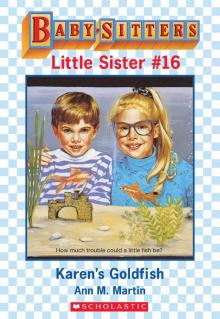 Karen's Goldfish
Karen's Goldfish Snow War
Snow War Abby and the Secret Society
Abby and the Secret Society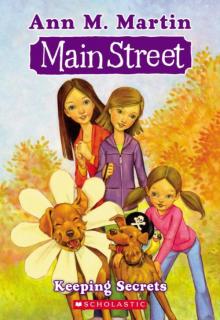 Keeping Secrets
Keeping Secrets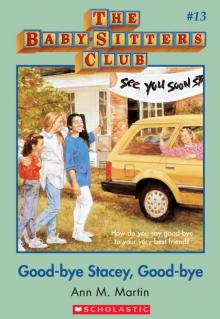 Good-Bye Stacey, Good-Bye
Good-Bye Stacey, Good-Bye Karen's Sleepover
Karen's Sleepover Claudia and the World's Cutest Baby
Claudia and the World's Cutest Baby Mary Anne Saves the Day
Mary Anne Saves the Day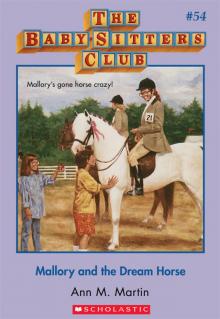 Mallory and the Dream Horse
Mallory and the Dream Horse Kristy and the Mystery Train
Kristy and the Mystery Train Dawn's Family Feud
Dawn's Family Feud Karen's Twin
Karen's Twin Little Miss Stoneybrook... And Dawn
Little Miss Stoneybrook... And Dawn Karen's Mistake
Karen's Mistake Karen's Movie Star
Karen's Movie Star Mallory and the Mystery Diary
Mallory and the Mystery Diary Karen's Monsters
Karen's Monsters Kristy + Bart = ?
Kristy + Bart = ? Karen's Dinosaur
Karen's Dinosaur Here Today
Here Today Karen's Carnival
Karen's Carnival How to Look for a Lost Dog
How to Look for a Lost Dog Stacey vs. Claudia
Stacey vs. Claudia Stacey's Ex-Boyfriend
Stacey's Ex-Boyfriend Here Come the Bridesmaids!
Here Come the Bridesmaids!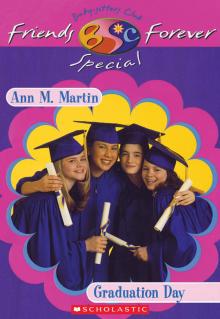 Graduation Day
Graduation Day Kristy's Big News
Kristy's Big News Karen's School Surprise
Karen's School Surprise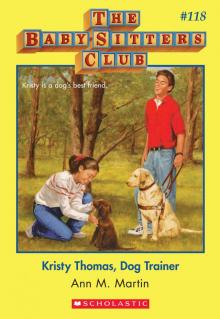 Kristy Thomas, Dog Trainer
Kristy Thomas, Dog Trainer Baby-Sitters' Christmas Chiller
Baby-Sitters' Christmas Chiller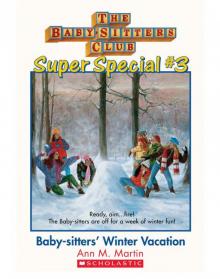 Baby-Sitters' Winter Vacation
Baby-Sitters' Winter Vacation Ten Good and Bad Things About My Life
Ten Good and Bad Things About My Life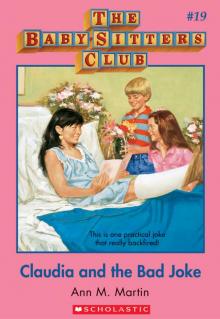 Claudia and the Bad Joke
Claudia and the Bad Joke Mary Anne's Makeover
Mary Anne's Makeover Stacey and the Fashion Victim
Stacey and the Fashion Victim Dawn Schafer, Undercover Baby-Sitter
Dawn Schafer, Undercover Baby-Sitter Karen's Tuba
Karen's Tuba Dawn's Wicked Stepsister
Dawn's Wicked Stepsister Diary Three: Dawn, Sunny, Maggie, Amalia, and Ducky
Diary Three: Dawn, Sunny, Maggie, Amalia, and Ducky Karen's Nanny
Karen's Nanny Jessi and the Awful Secret
Jessi and the Awful Secret Karen's New Year
Karen's New Year Karen's Candy
Karen's Candy Karen's President
Karen's President Mary Anne and the Great Romance
Mary Anne and the Great Romance Mary Anne + 2 Many Babies
Mary Anne + 2 Many Babies Kristy and the Copycat
Kristy and the Copycat Jessi and the Bad Baby-Sitter
Jessi and the Bad Baby-Sitter Claudia, Queen of the Seventh Grade
Claudia, Queen of the Seventh Grade Claudia and the Lighthouse Ghost
Claudia and the Lighthouse Ghost Karen's New Puppy
Karen's New Puppy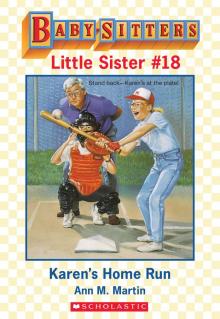 Karen's Home Run
Karen's Home Run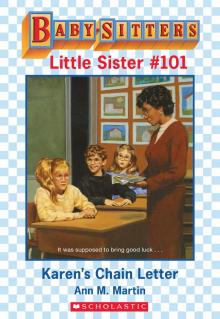 Karen's Chain Letter
Karen's Chain Letter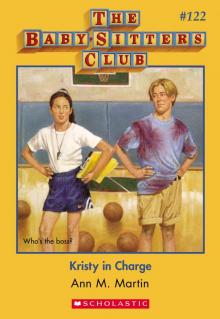 Kristy in Charge
Kristy in Charge Karen's Angel
Karen's Angel Mary Anne and Too Many Boys
Mary Anne and Too Many Boys Karen's Big Fight
Karen's Big Fight Karen's Spy Mystery
Karen's Spy Mystery Stacey's Big Crush
Stacey's Big Crush Karen's School
Karen's School Claudia and the Terrible Truth
Claudia and the Terrible Truth Karen's Cowboy
Karen's Cowboy The Summer Before
The Summer Before Beware, Dawn!
Beware, Dawn! Belle Teale
Belle Teale Claudia's Big Party
Claudia's Big Party The Secret Life of Mary Anne Spier
The Secret Life of Mary Anne Spier Karen's Book
Karen's Book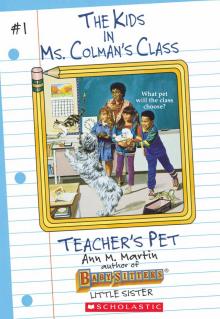 Teacher's Pet
Teacher's Pet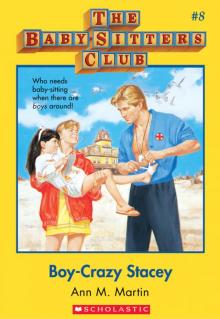 Boy-Crazy Stacey
Boy-Crazy Stacey Claudia and the Disaster Date
Claudia and the Disaster Date Author Day
Author Day Claudia and the Sad Good-Bye
Claudia and the Sad Good-Bye Kristy and the Worst Kid Ever
Kristy and the Worst Kid Ever Yours Turly, Shirley
Yours Turly, Shirley Class Play
Class Play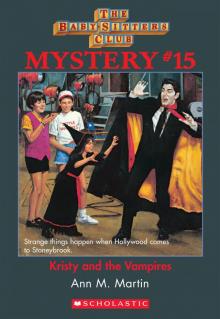 Kristy and the Vampires
Kristy and the Vampires Kristy and the Cat Burglar
Kristy and the Cat Burglar Karen's Pumpkin Patch
Karen's Pumpkin Patch Stacey and the Mystery at the Empty House
Stacey and the Mystery at the Empty House Karen's Chicken Pox
Karen's Chicken Pox Mary Anne and the Playground Fight
Mary Anne and the Playground Fight Stacey's Mistake
Stacey's Mistake Coming Apart
Coming Apart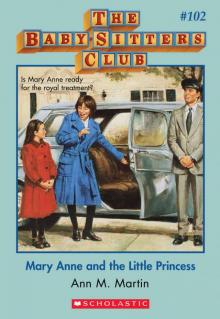 Mary Anne and the Little Princess
Mary Anne and the Little Princess Karen, Hannie and Nancy: The Three Musketeers
Karen, Hannie and Nancy: The Three Musketeers 'Tis the Season
'Tis the Season Claudia and Mean Janine
Claudia and Mean Janine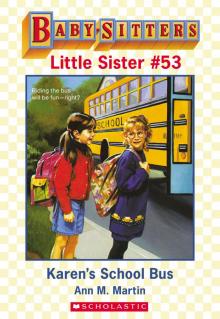 Karen's School Bus
Karen's School Bus Mary Anne's Big Breakup
Mary Anne's Big Breakup Rain Reign
Rain Reign Claudia and the Mystery at the Museum
Claudia and the Mystery at the Museum Claudia and the Great Search
Claudia and the Great Search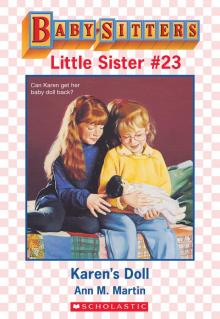 Karen's Doll
Karen's Doll Shannon's Story
Shannon's Story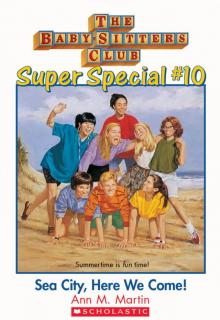 Sea City, Here We Come!
Sea City, Here We Come! Stacey and the Mystery of Stoneybrook
Stacey and the Mystery of Stoneybrook Karen's Treasure
Karen's Treasure Ten Rules for Living With My Sister
Ten Rules for Living With My Sister With You and Without You
With You and Without You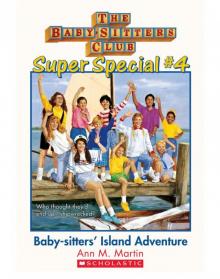 Baby-Sitters' Island Adventure
Baby-Sitters' Island Adventure Karen's Fishing Trip
Karen's Fishing Trip Dawn and the Big Sleepover
Dawn and the Big Sleepover New York, New York!
New York, New York! Ten Kids, No Pets
Ten Kids, No Pets Happy Holidays, Jessi
Happy Holidays, Jessi Halloween Parade
Halloween Parade Karen's New Holiday
Karen's New Holiday Kristy Power!
Kristy Power! Karen's Wish
Karen's Wish Claudia and the Mystery in the Painting
Claudia and the Mystery in the Painting Karen's Stepmother
Karen's Stepmother Abby in Wonderland
Abby in Wonderland Karen's Snow Day
Karen's Snow Day Kristy and the Secret of Susan
Kristy and the Secret of Susan Karen's Pony Camp
Karen's Pony Camp Karen's School Trip
Karen's School Trip Mary Anne to the Rescue
Mary Anne to the Rescue Karen's Unicorn
Karen's Unicorn Abby and the Notorious Neighbor
Abby and the Notorious Neighbor Stacey and the Haunted Masquerade
Stacey and the Haunted Masquerade Claudia Gets Her Guy
Claudia Gets Her Guy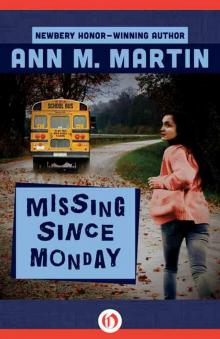 Missing Since Monday
Missing Since Monday Stacey's Choice
Stacey's Choice Stacey's Ex-Best Friend
Stacey's Ex-Best Friend Karen's New Teacher
Karen's New Teacher Karen's Accident
Karen's Accident Karen's Lucky Penny
Karen's Lucky Penny Karen's Cartwheel
Karen's Cartwheel Karen's Puppet Show
Karen's Puppet Show Spelling Bee
Spelling Bee Stacey's Problem
Stacey's Problem Stacey and the Stolen Hearts
Stacey and the Stolen Hearts Karen's Surprise
Karen's Surprise Karen's Worst Day
Karen's Worst Day The Ghost at Dawn's House
The Ghost at Dawn's House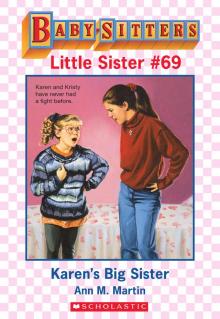 Karen's Big Sister
Karen's Big Sister Karen's Easter Parade
Karen's Easter Parade Mary Anne and the Silent Witness
Mary Anne and the Silent Witness Karen's Swim Meet
Karen's Swim Meet Mary Anne's Revenge
Mary Anne's Revenge Karen's Mystery
Karen's Mystery Stacey and the Mystery Money
Stacey and the Mystery Money Dawn and the Disappearing Dogs
Dawn and the Disappearing Dogs Karen's Christmas Tree
Karen's Christmas Tree Welcome to Camden Falls
Welcome to Camden Falls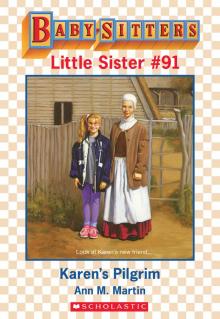 Karen's Pilgrim
Karen's Pilgrim Dawn and the Halloween Mystery
Dawn and the Halloween Mystery Mary Anne in the Middle
Mary Anne in the Middle Karen's Toys
Karen's Toys Kristy's Great Idea
Kristy's Great Idea Claudia and the Middle School Mystery
Claudia and the Middle School Mystery Karen's Big Weekend
Karen's Big Weekend Logan's Story
Logan's Story Karen's Yo-Yo
Karen's Yo-Yo Kristy's Book
Kristy's Book Mallory and the Ghost Cat
Mallory and the Ghost Cat Mary Anne and the Music
Mary Anne and the Music Karen's Tattletale
Karen's Tattletale Karen's County Fair
Karen's County Fair Karen's Mermaid
Karen's Mermaid Snowbound
Snowbound Karen's Movie
Karen's Movie Jessi and the Troublemaker
Jessi and the Troublemaker Baby-Sitters at Shadow Lake
Baby-Sitters at Shadow Lake Mallory on Strike
Mallory on Strike Jessi's Baby-Sitter
Jessi's Baby-Sitter Karen's Leprechaun
Karen's Leprechaun Claudia and the Phantom Phone Calls
Claudia and the Phantom Phone Calls Karen's Good-Bye
Karen's Good-Bye Karen's Figure Eight
Karen's Figure Eight Logan Likes Mary Anne!
Logan Likes Mary Anne! Mary Anne and the Zoo Mystery
Mary Anne and the Zoo Mystery Missy Piggle-Wiggle and the Whatever Cure
Missy Piggle-Wiggle and the Whatever Cure Dawn on the Coast
Dawn on the Coast Stacey and the Cheerleaders
Stacey and the Cheerleaders Claudia and the Clue in the Photograph
Claudia and the Clue in the Photograph Karen's New Friend
Karen's New Friend Mallory and the Trouble With Twins
Mallory and the Trouble With Twins Karen's Roller Skates
Karen's Roller Skates Abby and the Best Kid Ever
Abby and the Best Kid Ever Poor Mallory!
Poor Mallory! Karen's Witch
Karen's Witch Karen's Grandmothers
Karen's Grandmothers Slam Book
Slam Book Karen's School Picture
Karen's School Picture Karen's Reindeer
Karen's Reindeer Kristy's Big Day
Kristy's Big Day The Long Way Home
The Long Way Home Karen's Sleigh Ride
Karen's Sleigh Ride On Christmas Eve
On Christmas Eve Karen's Copycat
Karen's Copycat Karen's Ice Skates
Karen's Ice Skates Claudia and the Little Liar
Claudia and the Little Liar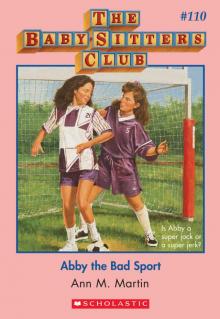 Abby the Bad Sport
Abby the Bad Sport The Baby-Sitters Club #5: Dawn and the Impossible Three
The Baby-Sitters Club #5: Dawn and the Impossible Three Abby's Book
Abby's Book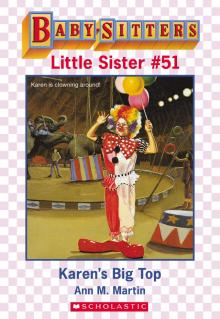 Karen's Big Top
Karen's Big Top Main Street #8: Special Delivery
Main Street #8: Special Delivery Kristy and the Kidnapper
Kristy and the Kidnapper Karen's Ski Trip
Karen's Ski Trip Karen's Hurricane
Karen's Hurricane Stacey and the Mystery at the Mall
Stacey and the Mystery at the Mall Jessi and the Superbrat
Jessi and the Superbrat Kristy and the Baby Parade
Kristy and the Baby Parade Karen's New Bike
Karen's New Bike Karen's Big City Mystery
Karen's Big City Mystery Baby-Sitters' European Vacation
Baby-Sitters' European Vacation Hello, Mallory
Hello, Mallory Dawn's Big Date
Dawn's Big Date Karen's Christmas Carol
Karen's Christmas Carol Jessi's Horrible Prank
Jessi's Horrible Prank Kristy and the Missing Fortune
Kristy and the Missing Fortune Kristy and the Haunted Mansion
Kristy and the Haunted Mansion Jessi's Big Break
Jessi's Big Break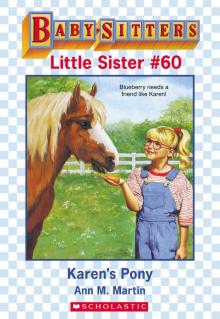 Karen's Pony
Karen's Pony Welcome Home, Mary Anne
Welcome Home, Mary Anne Stacey the Math Whiz
Stacey the Math Whiz September Surprises
September Surprises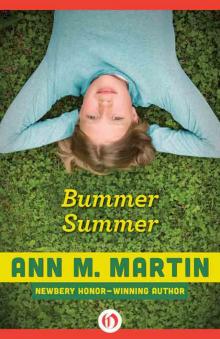 Bummer Summer
Bummer Summer Karen's Secret
Karen's Secret Abby's Twin
Abby's Twin Main Street #4: Best Friends
Main Street #4: Best Friends Karen's Big Move
Karen's Big Move Mary Anne Misses Logan
Mary Anne Misses Logan Stacey's Book
Stacey's Book Claudia and the Perfect Boy
Claudia and the Perfect Boy Holiday Time
Holiday Time Stacey's Broken Heart
Stacey's Broken Heart Karen's Field Day
Karen's Field Day Kristy's Worst Idea
Kristy's Worst Idea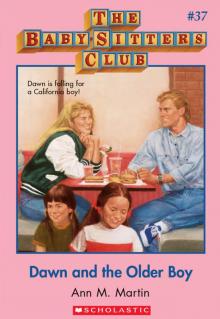 Dawn and the Older Boy
Dawn and the Older Boy Karen's Brothers
Karen's Brothers Claudia's Friend
Claudia's Friend Mary Anne and the Haunted Bookstore
Mary Anne and the Haunted Bookstore Dawn and Whitney, Friends Forever
Dawn and Whitney, Friends Forever Summer School
Summer School Karen's Birthday
Karen's Birthday Karen's Black Cat
Karen's Black Cat Stacey McGill... Matchmaker?
Stacey McGill... Matchmaker? Claudia's Book
Claudia's Book Main Street #2: Needle and Thread
Main Street #2: Needle and Thread Karen's Runaway Turkey
Karen's Runaway Turkey Karen's Campout
Karen's Campout Karen's Bunny
Karen's Bunny Claudia and the New Girl
Claudia and the New Girl Karen's Wedding
Karen's Wedding Karen's Promise
Karen's Promise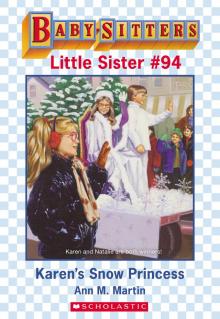 Karen's Snow Princess
Karen's Snow Princess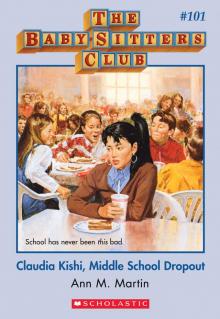 Claudia Kishi, Middle School Dropout
Claudia Kishi, Middle School Dropout Starring the Baby-Sitters Club!
Starring the Baby-Sitters Club! Kristy for President
Kristy for President California Girls!
California Girls! Maid Mary Anne
Maid Mary Anne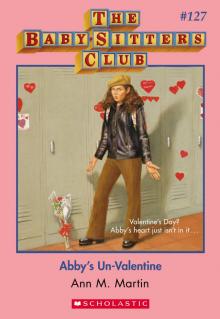 Abby's Un-Valentine
Abby's Un-Valentine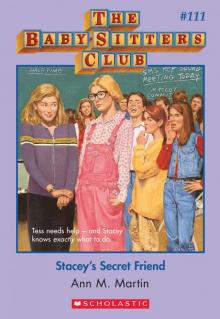 Stacey's Secret Friend
Stacey's Secret Friend Karen's Haunted House
Karen's Haunted House Claudia and Crazy Peaches
Claudia and Crazy Peaches Karen's Prize
Karen's Prize Get Well Soon, Mallory!
Get Well Soon, Mallory! Karen's Doll Hospital
Karen's Doll Hospital Karen's Newspaper
Karen's Newspaper Karen's Toothache
Karen's Toothache Mary Anne and Miss Priss
Mary Anne and Miss Priss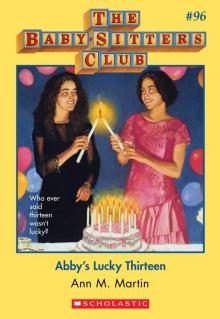 Abby's Lucky Thirteen
Abby's Lucky Thirteen The Secret Book Club
The Secret Book Club The All-New Mallory Pike
The All-New Mallory Pike Karen's Turkey Day
Karen's Turkey Day Karen's Magician
Karen's Magician Mary Anne and the Library Mystery
Mary Anne and the Library Mystery Diary One: Dawn, Sunny, Maggie, Amalia, and Ducky
Diary One: Dawn, Sunny, Maggie, Amalia, and Ducky Mary Anne and the Secret in the Attic
Mary Anne and the Secret in the Attic Kristy and the Mother's Day Surprise
Kristy and the Mother's Day Surprise Karen's in Love
Karen's in Love Welcome to the BSC, Abby
Welcome to the BSC, Abby Karen's Kittycat Club
Karen's Kittycat Club The Mystery at Claudia's House
The Mystery at Claudia's House The Truth About Stacey
The Truth About Stacey Karen's Bully
Karen's Bully Karen's Gift
Karen's Gift BSC in the USA
BSC in the USA Everything for a Dog
Everything for a Dog Dawn and the We Love Kids Club
Dawn and the We Love Kids Club Karen's Ghost
Karen's Ghost Stacey's Lie
Stacey's Lie Jessi's Secret Language
Jessi's Secret Language Kristy and the Missing Child
Kristy and the Missing Child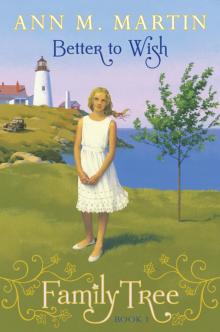 Better to Wish
Better to Wish Baby-Sitters on Board!
Baby-Sitters on Board! Kristy at Bat
Kristy at Bat Everything Changes
Everything Changes Don't Give Up, Mallory
Don't Give Up, Mallory A Dog's Life: The Autobiography of a Stray
A Dog's Life: The Autobiography of a Stray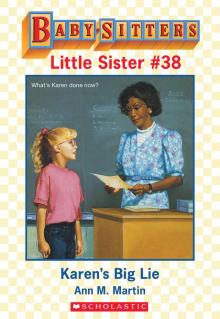 Karen's Big Lie
Karen's Big Lie Karen's Show and Share
Karen's Show and Share Mallory Hates Boys (and Gym)
Mallory Hates Boys (and Gym) Diary Two: Dawn, Sunny, Maggie, Amalia, and Ducky
Diary Two: Dawn, Sunny, Maggie, Amalia, and Ducky Karen's Pen Pal
Karen's Pen Pal Claudia and the Friendship Feud
Claudia and the Friendship Feud Karen's Secret Valentine
Karen's Secret Valentine Keep Out, Claudia!
Keep Out, Claudia!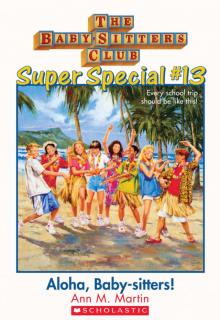 Aloha, Baby-Sitters!
Aloha, Baby-Sitters! Welcome Back, Stacey
Welcome Back, Stacey Jessi Ramsey, Pet-Sitter
Jessi Ramsey, Pet-Sitter Karen's Pizza Party
Karen's Pizza Party Kristy and the Dirty Diapers
Kristy and the Dirty Diapers Staying Together
Staying Together Dawn and the Surfer Ghost
Dawn and the Surfer Ghost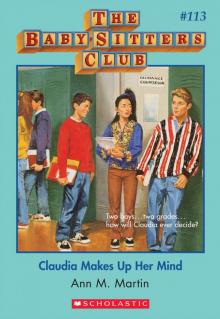 Claudia Makes Up Her Mind
Claudia Makes Up Her Mind Jessi's Gold Medal
Jessi's Gold Medal Karen's Kite
Karen's Kite Baby Animal Zoo
Baby Animal Zoo Dawn's Big Move
Dawn's Big Move Karen's Big Joke
Karen's Big Joke Karen's Lemonade Stand
Karen's Lemonade Stand Ma and Pa Dracula
Ma and Pa Dracula Baby-Sitters' Haunted House
Baby-Sitters' Haunted House Abby and the Mystery Baby
Abby and the Mystery Baby Home Is the Place
Home Is the Place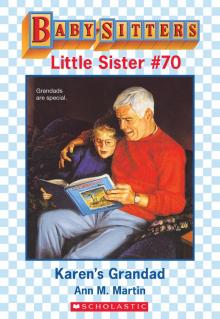 Karen's Grandad
Karen's Grandad Twin Trouble
Twin Trouble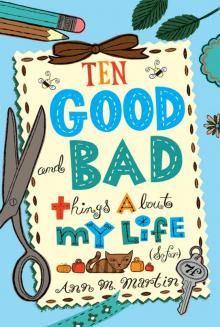 Ten Good and Bad Things About My Life (So Far)
Ten Good and Bad Things About My Life (So Far) Diary Two
Diary Two Baby-Sitters Club 027
Baby-Sitters Club 027 Claudia and the Mystery Painting
Claudia and the Mystery Painting Diary One
Diary One Baby-Sitters Club 037
Baby-Sitters Club 037 Baby-Sitters Club 028
Baby-Sitters Club 028 Baby-Sitters Club 085
Baby-Sitters Club 085 Dawn Schaffer Undercover Baby-Sitter
Dawn Schaffer Undercover Baby-Sitter Jessi's Babysitter
Jessi's Babysitter The Baby-Sitters Club #110: Abby the Bad Sport (Baby-Sitters Club, The)
The Baby-Sitters Club #110: Abby the Bad Sport (Baby-Sitters Club, The) Karen's Little Sister
Karen's Little Sister Baby-Sitters Club 058
Baby-Sitters Club 058 Claudia And The Genius On Elm St.
Claudia And The Genius On Elm St. Missy Piggle-Wiggle and the Sticky-Fingers Cure
Missy Piggle-Wiggle and the Sticky-Fingers Cure Kristy and Kidnapper
Kristy and Kidnapper Baby-Sitters Club 041
Baby-Sitters Club 041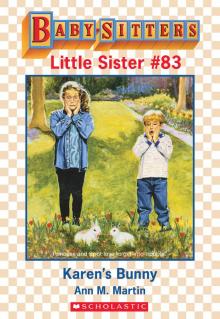 Karen's Bunny Trouble
Karen's Bunny Trouble Baby-Sitters Club 032
Baby-Sitters Club 032 Diary Three
Diary Three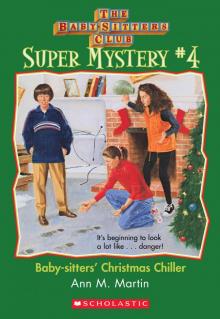 Christmas Chiller
Christmas Chiller Karen's Half-Birthday
Karen's Half-Birthday Needle and Thread
Needle and Thread Secret Life of Mary Anne Spier
Secret Life of Mary Anne Spier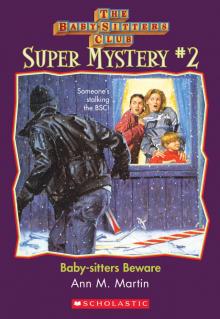 Baby-Sitters Beware
Baby-Sitters Beware Claudia Kishi, Middle School Drop-Out
Claudia Kishi, Middle School Drop-Out Logan Likes Mary Anne !
Logan Likes Mary Anne ! Baby-Sitters Club 061
Baby-Sitters Club 061 Best Friends
Best Friends Baby-Sitters Club 031
Baby-Sitters Club 031 Karen's Little Witch
Karen's Little Witch Jessi Ramsey, Petsitter
Jessi Ramsey, Petsitter Baby-Sitters Club 123
Baby-Sitters Club 123 Baby-Sitters Club 059
Baby-Sitters Club 059 Baby-Sitters Club 033
Baby-Sitters Club 033 Baby-Sitters Club 060
Baby-Sitters Club 060 Baby-Sitters Club 094
Baby-Sitters Club 094 The Baby-Sitters Club #99: Stacey's Broken Heart
The Baby-Sitters Club #99: Stacey's Broken Heart The Baby-Sitters Club #109: Mary Anne to the Rescue (Baby-Sitters Club, The)
The Baby-Sitters Club #109: Mary Anne to the Rescue (Baby-Sitters Club, The) Mystery At Claudia's House
Mystery At Claudia's House Claudia And The Sad Goodbye
Claudia And The Sad Goodbye Mary Anne's Big Break-Up
Mary Anne's Big Break-Up Baby-Sitters Club 025
Baby-Sitters Club 025 Baby-Sitters Club 042
Baby-Sitters Club 042 Stacey and the Mystery of the Empty House
Stacey and the Mystery of the Empty House Karen's Baby-Sitter
Karen's Baby-Sitter Claudia's Friendship Feud
Claudia's Friendship Feud Baby-Sitters Club 090
Baby-Sitters Club 090 Baby-Sitters Club 021
Baby-Sitters Club 021 Baby-Sitters Club 056
Baby-Sitters Club 056 Baby-Sitters Club 040
Baby-Sitters Club 040 The Baby-Sitters Club #108: Don't Give Up, Mallory (Baby-Sitters Club, The)
The Baby-Sitters Club #108: Don't Give Up, Mallory (Baby-Sitters Club, The) Dawn and the Impossible Three
Dawn and the Impossible Three The Snow War
The Snow War Special Delivery
Special Delivery Baby-Sitters Club 057
Baby-Sitters Club 057 Mary Anne And Too Many Babies
Mary Anne And Too Many Babies Baby-Sitters Club 030
Baby-Sitters Club 030